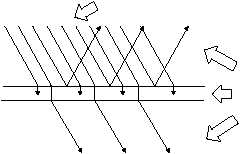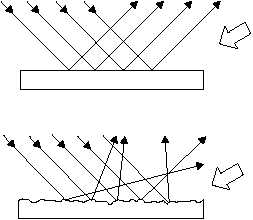Characteristics
When light waves encounter any substance, they
are either reflected, absorbed, or refracted. (See fig.
5-9.) Substances that permit the penetration of clear
vision through them and transmit almost all the light
falling upon them, such as glass and air, are transparent.
There is no known substance that is perfectly
transparent, but many are nearly so. Those substances
that allow the passage of part of the light but appear
clouded and impair vision substantially, such as frosted
light bulbs, are considered translucent. Those
substances that do not transmit any light are termed
opaque.
All objects that are not light sources are visible
only because they reflect all or some part of the light
reaching them from a luminous source. If light is
neither refracted nor reflected, it is absorbed or taken up
by the medium. When light strikes a substance, some
absorption and some reflection always takes place. No
substance completely refracts (transmits), reflects, or
absorbs all the light that reaches its surface. Figure 5-9
illustrates this refraction, absorption, and reflection of
light using a flat pane of glass.
Candlepower and Foot-candles
Illumination is the light received from a light
source. The intensity of illumination is measured in
foot-candles. A foot-candle is the amount of light
falling upon a 1-square-foot surface, which is 1 foot
away from a 1-candlepower light source.
REFLECTION
The term reflected light refers to those light waves
that are neither transmitted nor absorbed but are thrown
back from the surface of the medium they encounter. If
a ray of light is directed against a mirror, the light ray
that strikes the surface is called the incident ray; the one
that bounces off is the reflected ray (see fig. 5-10). The
imaginary line perpendicular to the mirror at the point
where the ray strikes is the normal. The angle between
the incident ray and the normal is the angle of
incidence. The angle between the reflected ray and the
normal is the angle of reflection.
If the surface of the medium contacted by the
incident light ray is smooth and polished, such as a
mirror, the reflected light is thrown back at the same
angle to the surface as the incident light. The path of the
light reflected from the surface forms an angle exactly
equal to the one formed by its path in reaching the
medium. This conforms to the law of reflection, which
states that the angle of incidence is equal to the angle of
reflection.
Reflection from a smooth-surfaced object presents
few problems. It is a different matter, however, when a
rough surface reflects light. The law of reflection still
holds but because the surface is uneven, the angle of
incidence is different for each ray of light. The reflected
light is scattered in all directions as shown in figure
5-11 and is called irregular or diffused light.
5-15
INCIDENT LIGHT RAYS
REFLECTED
RAYS
ABSORBED
RAYS
REFRACTED
RAYS
AG5f0509
Figure 5-9.—Light rays reflected, absorbed, and refracted.
INCIDENT
RAY
PERPENDICULAR
MIRROR
REFLECTED
RAY
ANGLE OF INCIDENCE
ANGLE OF REFLECTION
NORMAL OR
AG5f0510
Figure 5-10.—Terms used to describe the reflection of light.
AG5f0511
INCIDENT LIGHT
INCIDENT LIGHT
REFLECTED LIGHT
SPECULAR
DIFFUSED
REFLECTED LIGHT SCATTERED
(A)
(B)
Figure 5-11.—Reflected light. (A) Regular (specular); (B)
Irregular (diffused).





